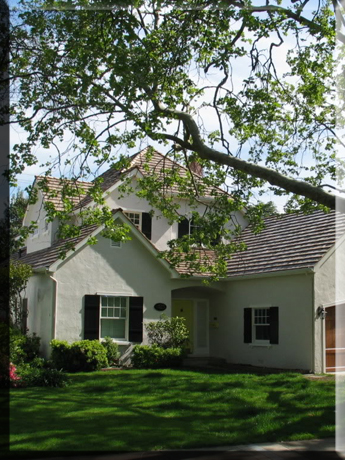| |
|
A Land Park Sanctuary
Project scope: Second story addition
Construction completed: Spring 2005
General contractor: Mills Builders
Location: Sacramento, California
Features of interest:
- 21st century façade improvement integrates 1950s home into its 1930s neighborhood.
- No change to first floor footprint.
- Sightlines through rooms to exterior for maximum light infiltration and perception of space.
- Second floor nestled within roof reduces visual bulk, respects neighbors and neighborhood scale: A useful design approach in meeting “daylighting” zoning requirements.
This project was one of my first, and was designed and built under the auspices of Michael Frank Malinowski, AIA.
This home began as a one-story, 1950s-era house, built in the Sacramento neighborhood of Land Park, known for it’s ‘20s and ‘30s-era cozy Tudor cottages, Spanish “villas”, and Craftsman gems. My practical goal was to add a master suite as well as a small office, and by so doing create a house that provided a more private—and spacious—sanctuary for the homeowners.
The aesthetic goal, along with these practical considerations, was to create a home that reflected the neighborhood’s pre-war heritage: the home should look as if it were built at the neighborhood’s inception. There were challenges to this in the front façade, especially. The garage, as was typical for the early 1950’s, was prominent and projecting, whereas a 1930’s home would almost always have had the garage detached and at the back of the lot. As budget did not allow a major overhaul to the site, we kept the garage where it was, but gave it a different character by the removal of the low hip roof in place of a cottage-style gable w/ attic window. This is an example a basic remodel tenet: if you can’t hide something, make it a feature.
As we did not want a towering structure on this narrow lot (only 50’ wide), we found that nestling the second floor within the steep roof planes which rested on the first floor’s plate, with a few gable dormers for more area and light, allowed us plenty of space yet kept the façade demure, comfortable, and welcoming.
Sightlines are an essential feature of this floor plan layout: Alignments are window, door, window, so that you can stand at one point along this line and see through one or two rooms to windows beyond, in either direction. The practical effect this has is to bring in the most amount of light possible, especially in small spaces: entrances to rooms are aligned with windows so that the light not only fills the room it’s in but continues into the rooms or hall beyond. The psychological effect this has is to make the space appear to have much more volume than it actually has. This, in combination with a view to the outside, which relaxes the eye, and incorporates the interior with the trees and sky beyond, tends to create a peaceful environment, where flow seems unencumbered by the brick-a-brack of daily life.
|
|
|
|
| |

Project Gallery
-
 BEFORE: Front view BEFORE: Front view
Your standard-issue one-story post-WWII suburban home, soon to be transformed. In tearing open a wall the owner found his grandfather's signature on one of the wall studs.. unbeknownst to the owner, he'd been living in a house his grandfather had built half a century earlier (it was a common practice for a builder to "autograph" a home he built, usually on a wall stud or rafter).
-
 BEFORE: Front view BEFORE: Front view
-
 AFTER: New front elevation AFTER: New front elevation
Note when comparing the new to the old that the first floor layout, including window and door locations, remains the same. Smooth-finish stucco, with surface modulations evoking a plaster-on-stone appearance, dutch gables, dormers, and new windows and doors provide a new sense of stability and rootedness to the home.
-
 BEFORE: Back elevation BEFORE: Back elevation
-
 AFTER: Back elevation AFTER: Back elevation
New master suite balcony, w/ the home's original 1950s row of windows below, integrated with the new aesthetic. Note the projecting gabled element to the right of the balcony: providing dimensionality like this breaks up what otherwise could be a monolithic facade, keeping everything at a human scale.
-
 Back elevation Back elevation
The dutch gable at both the front and back helps to diminish the looming effect a second story might otherwise have.
-
 View to master bedroom View to master bedroom
From the new upstairs hallway, a view to the new master bedroom. A barrel archway over two feet deep separates the master suite from more public areas, providing both sound isolation and a sense of transition.
-
 New second story master bedroom New second story master bedroom
Double French doors open to small back balcony. Barrel vaulted dormer brings in additional light, centered above bed.
-
 New second story master bedroom New second story master bedroom
Existing brick chimney is left exposed. Barrel vault to hallway and stairs.
-
 View from master bedroom to hall and front window View from master bedroom to hall and front window
An example of sightlines: view from master bedroom to stair hall/landing. Echo of architectural elements: barrel vault over arched door, with arched window beyond.
-
 New Master Bath New Master Bath
-
 New Master Bath New Master Bath
-
 New Master bath New Master bath
|
|